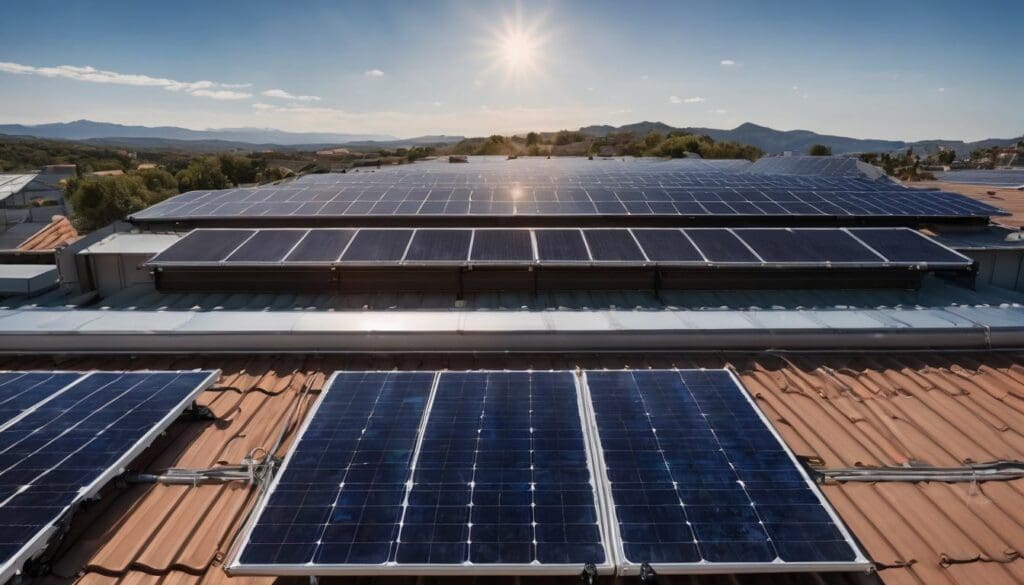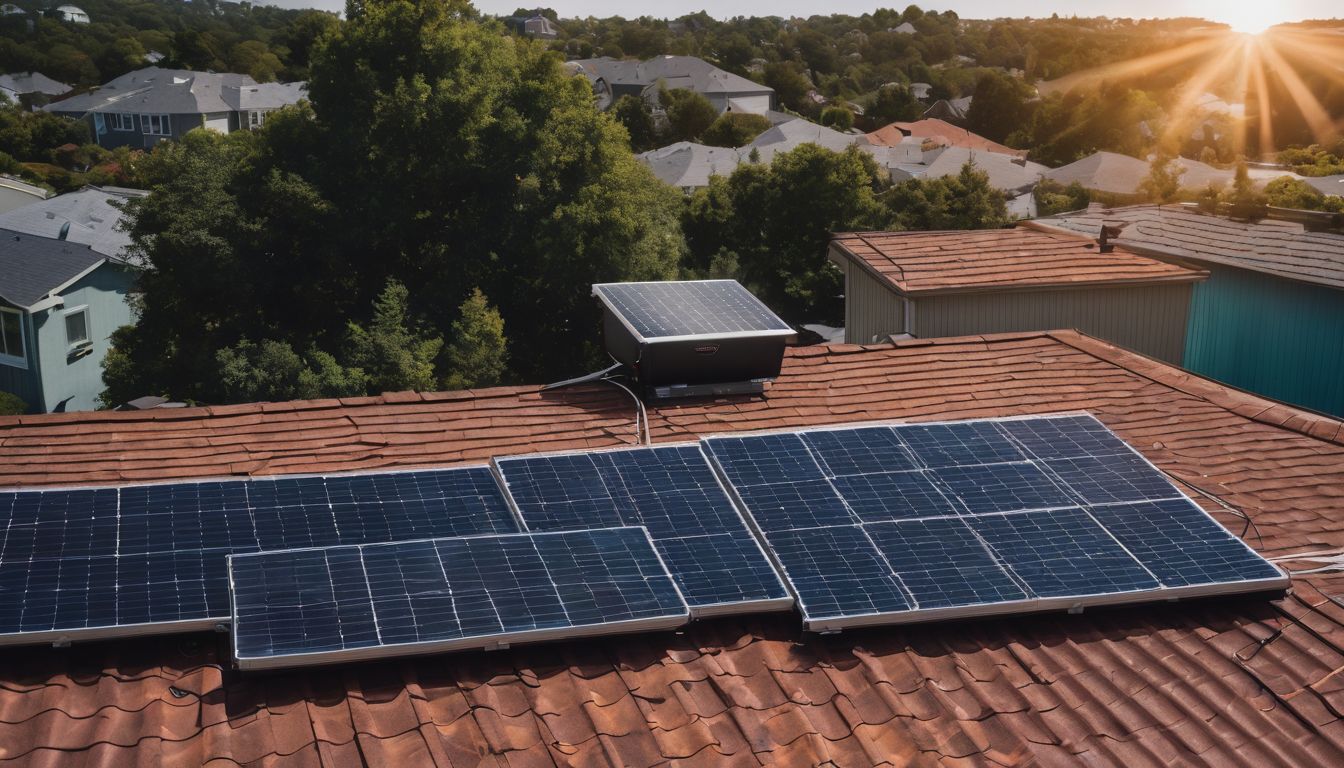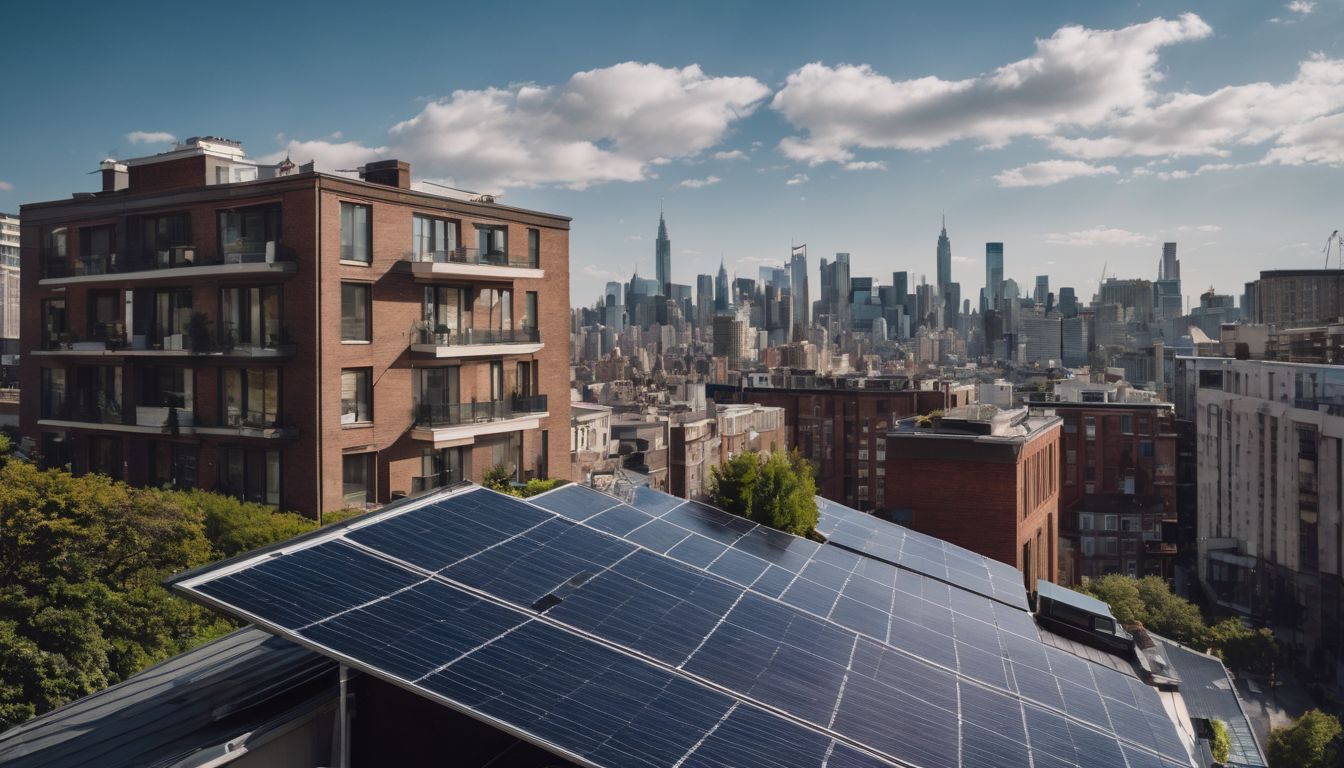Many of us worry about the impact we’re having on our planet. Every year, solar panels help prevent millions of tonnes of carbon emissions from entering our atmosphere. This article will explore how harnessing the power of the sun can significantly lower your personal contribution to global greenhouse gas levels.
Read on to see how you can make a difference!
Key Takeaways
- Solar panels produce significantly lower CO2 emissions than traditional energy sources, with an approximate 50 grams of CO2 per kWh compared to about 1000 for coal and 450 for natural gas.
- Choosing a reputable solar company is key; they should provide high-quality panels, efficient installation, comprehensive warranties, and follow sustainable practices.
- Proper maintenance of solar equipment includes regular cleaning of the panels and monitoring system performance to ensure peak efficiency and extend its lifespan.
- Understanding electric rates and billing can help maximise the financial benefits of solar energy while also contributing to carbon footprint reduction by using energy more efficiently during off-peak times.
- Factors affecting the carbon footprint of solar panels include location and methods used in production, materials sourced for manufacturing, efficiency in the production process, transportation, installation procedures, and end-of-life recycling or disposal.
What is a Carbon Footprint?
A carbon footprint is the total amount of greenhouse gases, particularly carbon dioxide, that are emitted directly or indirectly by human activities. It’s important to reduce our carbon footprint to mitigate climate change and its impacts on the environment.
Definition
Your carbon footprint measures the total greenhouse gas emissions caused directly and indirectly by a person, organisation, event or product. It includes carbon dioxide—the main culprit of climate change—as well as other gases like methane and nitrous oxide.
Each activity in our daily lives, from driving cars to heating homes, contributes to these emissions.
Reducing your carbon footprint is crucial for slowing down global warming and keeping our planet healthy. Switching to renewable energy sources such as solar power plays a significant role in this effort.
Solar panels take energy from the sun—a clean and abundant source—transform it into electricity without burning fossil fuels or creating pollution. This switch not only promotes sustainable living but also leads towards achieving a carbon-neutral lifestyle where we balance out our emissions with actions that help remove carbon from the atmosphere.
Importance of reducing carbon footprint
Reducing carbon footprint is crucial for preserving the environment and mitigating climate change. Making conscious choices to lower our environmental impact through sustainable practices like using solar energy can significantly contribute to this goal.
By embracing clean energy sources, individuals can actively reduce pollution, decrease reliance on fossil fuels, and promote eco-friendly living. This switch not only benefits the planet but also supports a more sustainable future for generations to come.
By integrating alternative energy sources like solar power into daily life, one can play an active role in reducing greenhouse gas emissions while simultaneously benefiting from cost-effective and environmentally friendly energy solutions.
How Solar Energy Can Help Reduce Your Carbon Footprint
Solar energy can help reduce your carbon footprint by producing lower CO2 emissions compared to other energy sources, and its production and installation processes have a lower environmental impact.
Additionally, the operational and maintenance processes of solar panels contribute to reducing greenhouse gas emissions.
Lower CO2 emissions compared to other energy sources
Solar energy offers a significant advantage in the reduction of CO2 emissions when compared to other energy sources. By harnessing the power of sunlight to generate electricity, solar panels produce minimal greenhouse gases and air pollutants during their operational lifespan.
This clean and sustainable energy source provides an effective way to decrease carbon footprints and mitigate climate change impacts, contributing to a more environmentally friendly and healthy planet.
In addition, solar power can play a crucial role in promoting fossil fuel independence and reducing reliance on conventional energy sources that significantly contribute to environmental degradation.
Embracing solar energy enables individuals to actively participate in emission reduction technologies without compromising on their daily lifestyle or economic well-being – directly impacting pollution reduction and supporting environmental conservation efforts.
Production and installation process
Solar panels are produced using materials like silicon, metals, and glass. These materials are assembled to create photovoltaic modules that convert sunlight into electricity. The installation process involves mounting the solar panels on the roof or in an open area with maximum exposure to sunlight.
This is typically done by trained professionals who ensure proper positioning for optimum energy generation. Once installed, the solar panels require minimal maintenance, such as regular cleaning and inspection to ensure optimal performance.
During production, manufacturers strive to reduce their carbon footprint by using sustainable practices and minimising waste. The installation process involves anchoring the panels securely while considering aesthetics and functionality.
Operational and maintenance processes
Solar panels require regular maintenance to ensure optimal performance and longevity. This includes cleaning the panels to remove dirt, dust, and debris that can reduce efficiency.
Regular inspections are also essential to identify any potential issues early on, such as loose connections or damage from extreme weather conditions. Additionally, monitoring energy production and checking for any abnormalities in the system is crucial for ensuring everything operates smoothly.
To maintain eco-friendliness of solar energy systems, it’s important to use environmentally friendly cleaning solutions when washing the panels. Keeping an eye on the equipment’s performance enables timely detection of any malfunctions which can result in reduced greenhouse gas emissions and contribute positively towards climate change mitigation efforts.
Calculating the Carbon Footprint of Solar Panels
When it comes to solar panels, calculating the carbon footprint is essential in understanding their environmental impact. Factors such as production processes and energy efficiency play a key role in determining how much carbon emissions are reduced compared to other energy sources.
Comparison with other energy sources
Solar panels have a significantly lower carbon footprint when compared to traditional energy sources. Below is a table outlining the comparison:
| Energy Source | Carbon Footprint (grams of CO2 per kWh) |
|---|---|
| Solar Panels | Approx. 50 |
| Coal | Approx. 1000 |
| Natural Gas | Approx. 450 |
| Nuclear | Approx. 12 |
| Hydropower | Approx. 24 |
| Wind | Approx. 11 |
Solar energy emerges as a clear leader in low-carbon electricity, showcasing its potential to drastically reduce greenhouse gas emissions.
Factors that affect carbon footprint
When comparing solar energy with other energy sources, it’s important to consider the factors that affect carbon footprint. Here are the key aspects:
- Location of solar panel production facilities can impact transportation emissions.
- The type and origin of materials used in solar panels influence carbon footprint.
- Energy efficiency during the manufacturing process affects overall carbon emissions.
- Method of disposal or recycling at the end of a solar panel’s life cycle impacts its environmental footprint.
- Transportation and installation processes contribute to the overall carbon emissions of solar energy systems.
Ways to Lower Your Carbon Footprint with Solar Energy
Choose a reputable solar company to ensure the installation and maintenance of your solar panels are done properly. Understand electric rates and billing to maximise the benefits of solar energy.
Choosing a reputable solar company
When considering solar energy, research reputable solar companies that have a proven track record in the industry.
- Select a company with positive customer reviews and testimonials to ensure customer satisfaction and reliability.
- Look for certifications and accreditations from recognised organisations, demonstrating the company’s commitment to quality and environmental standards.
- Ensure that the chosen company provides comprehensive warranties, including performance guarantees and maintenance services, to protect your investment in solar energy.
- Seek transparent pricing and detailed quotations from multiple companies to compare costs, ensuring you receive the best value for your investment.
- Consider consulting with experts or environmental organisations to guide your choice towards a reputable solar company with a strong commitment to sustainability and eco-friendly practices.
Understanding electric rates and billing
Understanding electric rates and billing is crucial for maximising the benefits of solar energy. By comprehending how your electricity consumption is billed, you can optimise your usage to save costs and reduce carbon emissions.
Being aware of peak hours and off-peak periods allows you to schedule heavy energy-consuming activities when rates are lower, thereby lowering your overall carbon footprint while also benefiting financially.
Renewable energy sources like solar power often fluctuate in their production, which should be aligned with the billing structure to get the most out of environmentally friendly power sources.
Partnering with a reputable solar company can further assist you in understanding your electric rates and how they impact both the environment and your wallet.
Proper equipment maintenance
To reduce your carbon footprint with solar energy, it’s crucial to prioritise proper equipment maintenance. This involves:
- Regular cleaning of solar panels to ensure maximum sun exposure and energy production.
- Checking for any signs of wear or damage on the solar panels and associated components.
- Ensuring that the electrical connections remain secure and free from corrosion.
- Monitoring the performance of the solar system to detect any issues early on.
Conclusion
In summary, solar energy provides an eco-friendly solution to reducing your carbon footprint. It offers a way to lower CO2 emissions and reduce greenhouse gas production. By embracing solar power technology, individuals can actively contribute to environmental conservation efforts.
Making the switch to solar energy is a step towards a more sustainable future for our planet.
FAQs
1. What is a carbon footprint, and how does solar energy help reduce it?
A carbon footprint measures all the greenhouse gases we individually produce. By switching to solar power, you use green technology that doesn’t release these gases, helping you become more carbon neutral.
2. Can using solar energy make my home eco-friendly?
Yes! Solar panels convert sunlight into electricity without harmful emissions, making your house greener and aiding in greenhouse gas reduction.
3. Are there any additional benefits of using solar power besides reducing my carbon footprint?
Absolutely! Solar power benefits include lowering your energy bills and relying less on fossil fuels, which helps protect the environment for future generations.
4. How significant is the impact of solar energy on the environment?
Solar energy has a substantial positive impact by decreasing reliance on non-renewable resources and cutting down on greenhouse gas emissions that contribute to climate change.





